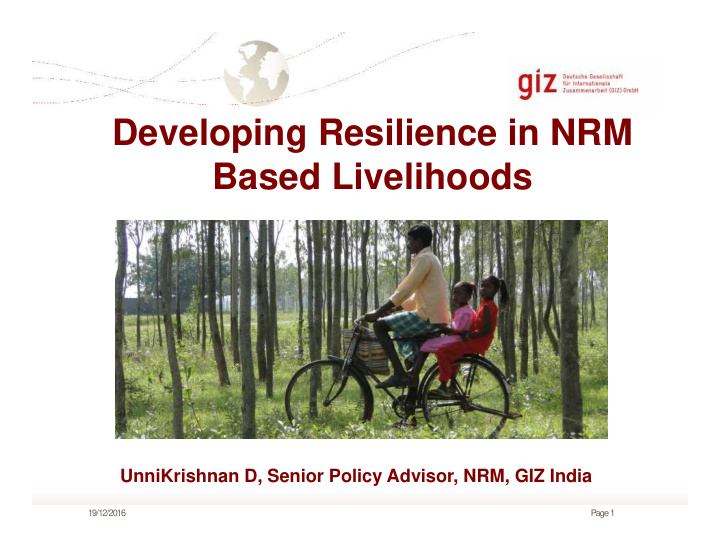



Developing Resilience in NRM Based Livelihoods UnniKrishnan D, Senior Policy Advisor, NRM, GIZ India 19/12/2016 Page1
India has Huge Climate Finance Requirement • Adaptation - in agriculture, forestry, fisheries infrastructure, water resources, and ecosystems - US $206 billion till 2030 Mitigation activities for moderate low carbon development - USD • 834 billion till 2030 NAPCC / SAPCC Assessment USD 189 billion for implementing • envisaged plans Source: INDIA’S INTENDED NATIONALLY DETERMINED CONTRIBUTION (INDC) 12/19/2016 company presentation 2013 Page2
Vulnerability of Indian to Climate Change • Long Coastline • High dependence on glacier fed rivers • Heavy dependence on monsoon for dry land agriculture • Rich mineral resources sitting on core forest area. 19/12/2016 company presentation 2012 Page3
Climate Change Worsening Current Agriculture Situation Soil Health Vs Crop Productivity Needs • Soil erosion • Fertility loss and poor fertilizer use efficiency • Desertification, • Water logging, • Salinity and alkalinity, • Wastelands 19/12/2016 company presentation 2012 Page4
Crop Production • 80% of our food procurement from 5-6 states • Farm yields of pulses and oilseeds way below global average • Market driven and not natural resource /climate / carrying capacity based cropping pattern • Doubling of farmers income Vs Farmers quitting farming • Shifting from food crop to cash crop and related farmers distress - Quality and timely credit 19/12/2016 company presentation 2012 Page5
Water • Indian agriculture is both under irrigated (net irrigated area about 45%) and over irrigated (more than 60% irrigation from ground water • High intensity of storage structures and relatively low area under irrigation • Overall imbalance of natural supply and local demand in ground water • Very low coverage under micro irrigation • Spatial inequality in access of irrigation 19/12/2016 company presentation 2012 Page6
Umbrella Program for Natural Resource Management (UPNRM) Linking Credits with Livelihoods and NRM An Indo-German bilateral policy based programme supported by KfW and GIZ, Implementation Since 2009 More than 300 projects worth more than 500 crore in 22 states Page7
UPNRM – promoting adaptation effectiveness 1. Blended Financing approach “Loan plus Grant” 2. 5 Guiding principles 4 project selection: Pro-poor, • Ensuring sustainability, • Community participation, • Good governance, • Integrated and needs based approach • 3. Loans + Capacity Building Support 4. Environmental, social and governance concerns are prerequisite for UPNRM projects 5. Complement, mainstream and fast-track public investments 12/19/2016 company presentation 2013 Page8
Technical Cooperation Financial Cooperation Loan (94% Loan (94% ) + Grant (6% ) + Grant (6% ) ) Loan Recepients/Channel Partners Loan Recepients/Channel Partners T echnical Repaym ent Support +Loan Farm Farm ers ers Umbrella Program for Natural Resource Inclusive andclim Inclusive andclim ate ate Management: resilient developm resilient developm ent ent Linking Credits with of thevulnerable of thevulnerable Project Project Livelihoods and NRM com com m m unities. unities. Activities Activities Page9
UPNRM Sector-wise Distribution 34 Sectors covered Miscellaneous Agriculture and 16% Allied Activities 26% Integrated Animal Husbandry 15% Animal Husbandry Orga 11% nic… Market ing… Fisheries NTFP Efficient Irrigation 3% 4% 12% Page10
District wise UPNRM Projects Very Low Low Medium High Very High GoI Vulnerability Atlas of Indian Agriculture to Climate Change Page11
Climate Resilient Financing A Snapshot 12/19/2016 company presentation 2013 Page12
RELIEF TO MOTHER EARTH Organic farming and vermicomposting, Nilagiri Foundation, Andhra Pradesh Page13
Building Resilience – Soil Health Page14
HEALTH AND WEALTH FROM LIVESTOCK Integrated dairy management, MASS, Andhra Pradesh Page15
FISHING FOR GROWTH Integrated fish farming, Gram-Utthan, Orissa Page16
Page17
Tissue culture banana with intercropping, IRA, Bihar NURSING THE BETTER BANANA Page18
HERBS HEALING LIVELIHOODS Sustainable collection of medicinal plants, GMCL, Tamil Nadu Page19
SWEET SUCCESS Eco-friendly honey harvesting, CBeeD, Maharashtra Page20
RISING TREES – RAISING INCOMES Agro-forestry with intercropping, PACL,Orissa Page21
Efficient irrigation and water management, Dilasa, Maharashtra SMART DROPS FOR HEALTHY CROPS Page22
Installation of energy efficient irrigation pumps, BESCOM & ENZEN, Karnataka POWERFUL PARTNERSHIP Page23
System of Rice Intensification (SRI), SKDRDP, Karnataka A FRUITFUL FORMULA – MORE FROM LESS Page24
Ecotourism and inclusive community development, VGKK, Karnataka ECO-PACKAGE FOR HEALTHY LEISURE Page25
CRUSHING POVERTY WITH COCONUTS Coir fibre processing, TNKKSS, Karnataka Page26
Improved Cook Stoves 12/19/2016 Page27
How could blended financing transform future decision- making on climate change financing? Integrating climate resilience into NRM- viable business • models model for seeking complementary adaptation financing (e. • g. Adaptation Fund Board, Green Climate Fund etc.) potential business model for commercial banks --- • convergence model for accessing public & private sector finance 12/19/2016 company presentation 2013 Page28
Financing Climate Change Adaptation Quantum of finances required Actual funds available-public funding Financing gaps Sources from where finances will flow Need Assessment of current and future climate risk under different scenarios Identification of adaptation actions and its associated cost Understanding the quantum of uncovered risk. 12/19/2016 company presentation 2013 Page29
National & International Sources of Climate Finance Green Climate Fund (GCF) 1. GCF 7. State Adaptation Fund under the UNFCCC 2. AF Budget National Clean Environment Fund (NCEF), MoFGoI Climate Climate Change Action Programme, MoEFCC, GoI Finance 6. Bilatera 3. NCEF National Adaptation Fund withMoEFCC, GoI l Bilateral Sources 5. 4. CCAP NAFCC State Budget, Private Sector and Markets 19.12.2016 XXX Page30
Funding Windows & Financing Mechanisms Green Climate Fund (GCF) Funding Windows Financing Mechanisms - Direct Access - Loan - International Access - Grant - Enhanced Direct Access - Blended financing facilities - Private Sector Facility - Guarantees - Equity Financing etc. Page31
Thank You UnniKrishnan D Senior Policy Advisor (Natural Resource Management) GIZ India 1st floor, A-2/18, Safdurjung Enclave New Delhi, 110029, India T + 91 11 49495353 (exten-3315) 12/19/2016 company presentation 2013 Page32
Recommend
More recommend